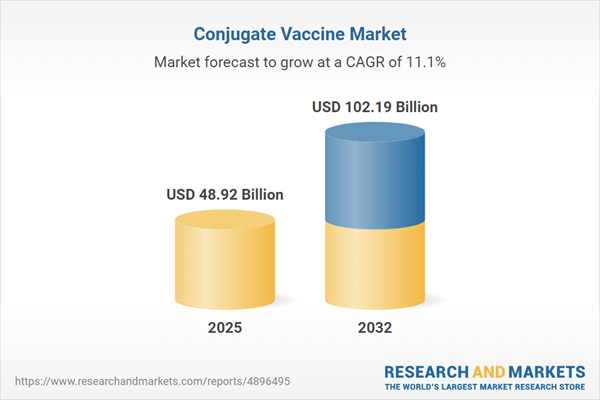Speak directly to the analyst to clarify any post sales queries you may have.
The conjugate vaccine market is rapidly evolving as organizations respond to changing public health needs, regulatory pressures, and technological innovation. Senior executives require actionable market intelligence to stay competitive and lead transformation within the immunization landscape.
Market Snapshot: Conjugate Vaccine Market Size and Growth
In 2024, the global conjugate vaccine market reached USD 43.92 billion, with momentum built on widespread immunization initiatives across multiple geographies. The market is projected to grow at a compound annual growth rate of 11.13%, achieving USD 48.92 billion by 2025 and expected to climb to USD 102.19 billion by 2032. These advances are supported by continuous improvements in vaccine research, collaboration between industry and governments, and evolving regulatory practices. Organizations expanding their participation in this space benefit from initiatives that broaden vaccine access and leverage modern healthcare infrastructure, creating clear opportunities for competitive differentiation and sustained leadership.
Scope & Segmentation of the Conjugate Vaccine Market
This analysis offers detailed segmentation and technological insights, providing senior decision-makers with the clarity needed to allocate resources efficiently in a complex healthcare ecosystem. Strategic segmentation enables firms to address distinct market requirements across global regions and adapt to emerging trends.
- Product Type: Haemophilus influenzae type B (Hib), meningococcal, and pneumococcal conjugate vaccines form the foundation for region-specific immunization programs that align with public health goals and epidemiological profiles.
- Distribution Channel: Pharmacies, clinics, and hospitals remain central to vaccination delivery, while expanded use of telemedicine increases reach in remote or underserved markets.
- Technology: Carrier proteins such as Crm197, Dt, and Tt directly support vaccine efficacy, adaptability, and duration, driving ongoing innovation in immunization approaches and safety profiles.
- End User: Clinics are essential for widespread immunization, addressing routine population-level vaccination needs; hospitals serve more complex cases and manage sophisticated supply workflows.
- Regional Coverage: Analysis covers North America, South America, Europe, Asia-Pacific, the Middle East, and Africa, spotlighting the strategic roles of the United States, China, Germany, and India in setting benchmarks and shaping adoption curves.
- Company Profiles: Key profiles include Pfizer Inc., GlaxoSmithKline plc, Sanofi S.A., Merck & Co., and Serum Institute of India, evaluating their global expansion, technological alliances, and scaling strategies across diverse health systems.
Key Takeaways for Senior Decision-Makers
- Advancements in carrier protein and adjuvant innovations help optimize immunization programs, maintaining readiness in the face of emerging disease threats and rapidly shifting health priorities.
- Digital distribution and virtual care models are increasingly valuable, improving vaccine accessibility and reducing operational barriers, especially during disruptions or in hard-to-reach locations.
- Stronger partnerships with pharmaceutical, biotechnology, and contract manufacturing stakeholders reinforce supply chain integrity, supporting rapid market response and risk mitigation in procurement.
- Data-driven vaccine management enables organizations to adapt program execution in real time, responding efficiently to local market dynamics and resource fluctuations.
- Integrated procurement and distribution approaches improve cost control and ensure consistent vaccine supply, protecting against market volatility and contributing to seamless operations.
Tariff Impact on Conjugate Vaccine Supply Chains
US tariff frameworks are prompting organizations to redesign global supply chains for conjugate vaccines, often leading to more diverse sourcing and local manufacturing initiatives. This trend supports supply continuity for critical ingredients, such as carrier proteins and adjuvants, increasing resilience in volatile trade environments. Collaborative relationships among payment platforms and healthcare organizations remain key for managing costs and ensuring reliable vaccine delivery when trade scenarios shift.
Methodology & Data Sources
This report’s findings are based on comprehensive secondary research using sources from top health authorities, global regulatory bodies, and relevant academic literature. Industry leaders and procurement experts have validated all data, resulting in practical, strategy-focused insights.
Why This Report Matters: Strategic Value for Decision-Makers
- Provides structured frameworks for resource optimization and nuanced risk management during periods of regulatory change or technology upgrades.
- Equips senior executives with reliable market intelligence for market entry, geographic expansion, and tactical positioning decisions.
- Identifies crucial market opportunities across different segments and regions to aid in executing long-term strategic plans with confidence.
Conclusion
With objective analysis and forward-looking perspectives, leaders can proactively shape their organizations’ roles in the evolving conjugate vaccine market, responding nimbly to new challenges while advancing sustainable growth.
Additional Product Information:
- Purchase of this report includes 1 year online access with quarterly updates.
- This report can be updated on request. Please contact our Customer Experience team using the Ask a Question widget on our website.
Table of Contents
3. Executive Summary
4. Market Overview
7. Cumulative Impact of Artificial Intelligence 2025
Companies Mentioned
The companies profiled in this Conjugate Vaccine market report include:- Biological E. Limited
- Pfizer Inc.
- GlaxoSmithKline PLC
- Sanofi S.A.
- Merck & Co., Inc.
- Serum Institute of India Pvt. Ltd.
- Bharat Biotech International Ltd.
- Panacea Biotec Ltd.
- SK bioscience Co., Ltd.
- Bavarian Nordic A/S
Table Information
| Report Attribute | Details |
|---|---|
| No. of Pages | 198 |
| Published | November 2025 |
| Forecast Period | 2025 - 2032 |
| Estimated Market Value ( USD | $ 48.92 Billion |
| Forecasted Market Value ( USD | $ 102.19 Billion |
| Compound Annual Growth Rate | 11.1% |
| Regions Covered | Global |
| No. of Companies Mentioned | 11 |









